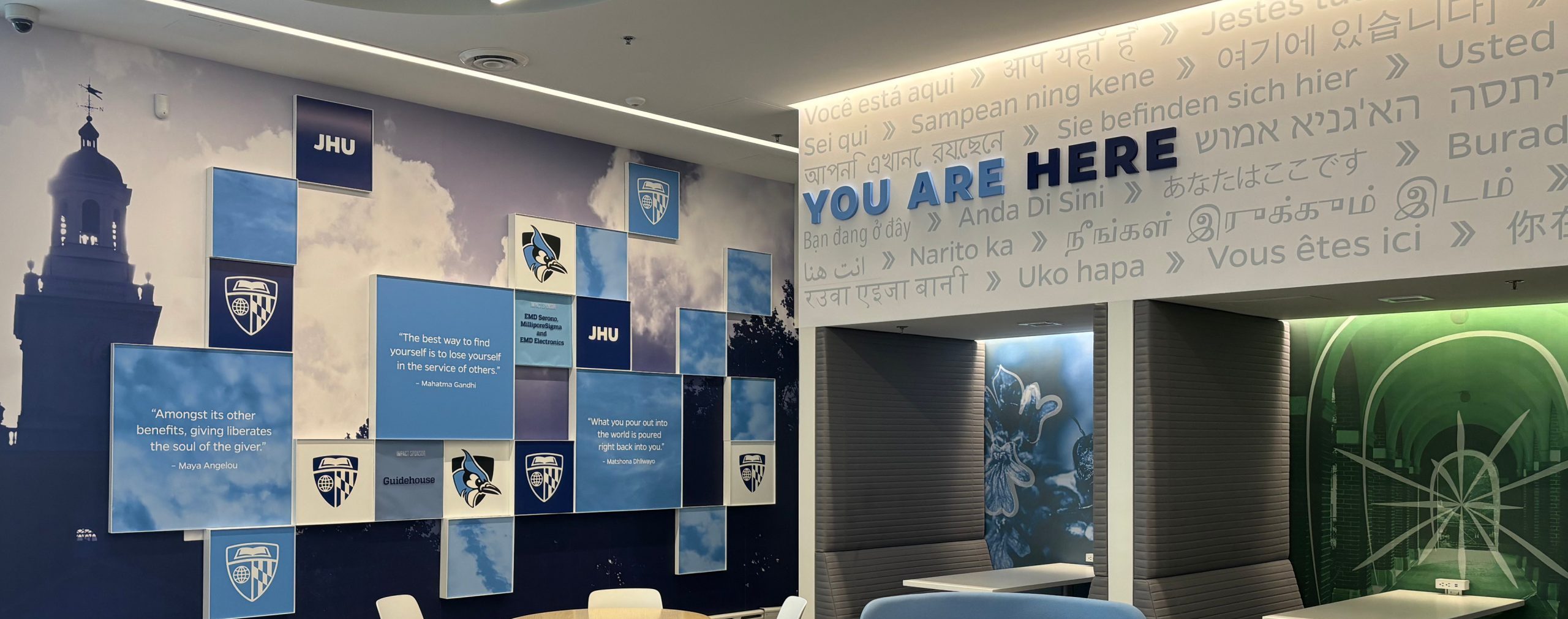
Messaging
Our messaging guidelines cascade from our overarching brand promise: to bring the benefits of discovery to the world.
Mission
To educate its students and cultivate their capacity for lifelong learning, to foster independent and original research, and to bring the benefits of discovery to the world.
Brand Pillars
Research. World. Excellence. Community.
Those are the words we heard most often when we spoke with faculty, staff, students, alumni, and trustees to develop our logo system in 2013 and were reiterated again when we spoke to constituents in 2022. That’s why the Johns Hopkins identity looks the way it does—with the book representing knowledge and discovery, the globe symbolizing our worldwide reach, and the crest of Lord Baltimore indicating our connection to our community.

Driven by Research
We believe curiosity inspires innovation. That is why year after year we’ve put more money into research than any other U.S. academic institution.

Knowledge for the World
The fabric of our university is woven together from people across the globe and we use that collective knowledge to address our world’s most complex challenges for betterment of our society.

Dedicated to Excellence
At Johns Hopkins, you can explore ideas that interest you, find people who inspire and challenge you, and make discoveries that change your life—and the world.

Commitment to Community
We understand that the continued flourishing of our university depends on the success and vitality of our city. As the city’s largest private employer, we recognize that we have a profound role to play in our shared community.
Naming Guidelines
When naming programs, events, initiatives, and campaigns keep the following best practices in mind:
- Use straightforward keywords and avoid jargon. Remember, clearly articulating what your event is or does is the most important factor when selecting a name. Creativity can be added in the execution of promoting that name (ex. Lighting of the Quads).
- Don’t merge words. Where there are legacy programs that do this (ex. HopkinsLocal) it is not recommended as doing so creates additional accessibility and readability hurdles to navigate.
- Only use Hopkins or JHU in the name if it’s enterprisewide (ex. Hopkins Votes is a campaign that spans all of Hopkins). Since most programs and campaigns will be presented in close proximity to the Johns Hopkins name and logo, it becomes redundant to also include “Hopkins” or “JHU” in the program title.
- Solve at scale. If your program is nested within another department or initiative, consider how those names will be used in context. For example, if you are seeking to name a program that is part of a larger campaign, make sure that introducing the additional name supports your goal without creating more confusion for your audience.
- Avoid acronyms. While tempting to consider, acronyms increase the time it takes someone to read and understand the message. Acronyms can have many meanings depending on the context (ex. “RAT” has been used to refer to Research Administration Training and the Risk Assessment Team). Additionally, acronyms introduce challenges when translating to global audiences.
View specific guidance for student organizations and club sports.
More Inspiration
Johns Hopkins Ten for One Strategic Plan 
Campaigns should ladder up to our overarching University strategic plan.
Voice & Tone 
Our voice characteristics are inspired by the qualities Gilman articulated in his inaugural address and that we continue to instill in our scholars today.
Editorial Style Guide 
These guidelines were compiled by editors in the Office of University Communications to encourage consistency and correct usage of terms across the many publications produced by JHU offices.